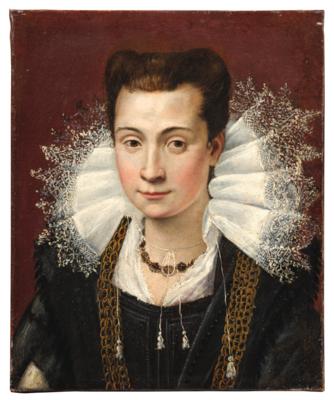Bolognese School, circa 1580
Portrait of a young noblewoman, bust-length, traditionally identified as Lavinia Fontana,
inscribed on the stretcher: Lavinia Fontana … / Anno 1[?]00 / Pingi il Suo Ritratto,
oil on canvas, 49 x 40.5 cm, framed
Provenance:
Private European collection
The young sitter is depicted wearing a sumptuous black velvet bodice, with a white partlet and a stiff lace collar, corresponding to late 16th century women’s fashion. Great attention is also paid to the representation of jewellery, as a symbol of high social status. An inscription on the back identifies the sitter with the painter Lavinia Fontana, and indeed her features can be compared to some of the artist’s self-portraits: the nose and the eyes are similar to Lavinia’s Self-Portrait at the Virginal painted in 1577 (Rome, Accademia di San Luca, inv. no. 743) and the hairline is comparable to that in her Self-Portrait signed and dated 1579 (Florence, Uffizi, inv. no. 4013). The Self-Portrait in red and black chalk, conserved in the Pierpont Morgan Library & Museum, New York (inv. no. IV, 158b) is also comparable.
The daughter of Bolognese painter Prospero Fontana, Lavinia trained in her father’s workshop, which was also frequented by some of the most important scientists and men of letters of the time, such as Ulisse Aldrovandi and Achille Bocchi. From the late 1570s onwards, her success grew rapidly, especially as a portrait painter. However, she also received commissions for major religious works, such as the altarpiece depicting The Holy Family’ sent to Philip II of Spain in 1589 (today in the Escorial, inv. no. 10045145). In 1603 Lavinia moved to Rome, working for prominent patrons including Cardinal Scipione Borghese; there she died in 1614. Considered by critics to be the first professional female painter, Lavinia Fontana was recently featured in a major monographic exhibition held by the National Gallery of Ireland (see Lavinia Fontana: Trailblazer, Rule Breaker, ed. by A. Brady, New Haven, 2023).
The canvas presented here can be stylistically compared to the paintings of another important Bolognese portraitist, Bartolomeo Passerotti, who frequented the Fontana family closely and exerted a strong influence on Lavinia’s work.
Esperto: Mark MacDonnell
 Mark MacDonnell
Mark MacDonnell
+43 1 515 60 403
oldmasters@dorotheum.com
24.04.2024 - 18:00
- Stima:
-
EUR 80.000,- a EUR 120.000,-
Osserva lotto Non osservare più
Bolognese School, circa 1580
Portrait of a young noblewoman, bust-length, traditionally identified as Lavinia Fontana,
inscribed on the stretcher: Lavinia Fontana … / Anno 1[?]00 / Pingi il Suo Ritratto,
oil on canvas, 49 x 40.5 cm, framed
Provenance:
Private European collection
The young sitter is depicted wearing a sumptuous black velvet bodice, with a white partlet and a stiff lace collar, corresponding to late 16th century women’s fashion. Great attention is also paid to the representation of jewellery, as a symbol of high social status. An inscription on the back identifies the sitter with the painter Lavinia Fontana, and indeed her features can be compared to some of the artist’s self-portraits: the nose and the eyes are similar to Lavinia’s Self-Portrait at the Virginal painted in 1577 (Rome, Accademia di San Luca, inv. no. 743) and the hairline is comparable to that in her Self-Portrait signed and dated 1579 (Florence, Uffizi, inv. no. 4013). The Self-Portrait in red and black chalk, conserved in the Pierpont Morgan Library & Museum, New York (inv. no. IV, 158b) is also comparable.
The daughter of Bolognese painter Prospero Fontana, Lavinia trained in her father’s workshop, which was also frequented by some of the most important scientists and men of letters of the time, such as Ulisse Aldrovandi and Achille Bocchi. From the late 1570s onwards, her success grew rapidly, especially as a portrait painter. However, she also received commissions for major religious works, such as the altarpiece depicting The Holy Family’ sent to Philip II of Spain in 1589 (today in the Escorial, inv. no. 10045145). In 1603 Lavinia moved to Rome, working for prominent patrons including Cardinal Scipione Borghese; there she died in 1614. Considered by critics to be the first professional female painter, Lavinia Fontana was recently featured in a major monographic exhibition held by the National Gallery of Ireland (see Lavinia Fontana: Trailblazer, Rule Breaker, ed. by A. Brady, New Haven, 2023).
The canvas presented here can be stylistically compared to the paintings of another important Bolognese portraitist, Bartolomeo Passerotti, who frequented the Fontana family closely and exerted a strong influence on Lavinia’s work.
Esperto: Mark MacDonnell
 Mark MacDonnell
Mark MacDonnell
+43 1 515 60 403
oldmasters@dorotheum.com
|
Hotline dell'acquirente
lun-ven: 10.00 - 17.00
old.masters@dorotheum.at +43 1 515 60 403 |
| Asta: | Dipinti antichi |
| Tipo d'asta: | Asta in sala con Live Bidding |
| Data: | 24.04.2024 - 18:00 |
| Luogo dell'asta: | Wien | Palais Dorotheum |
| Esposizione: | 13.04. - 24.04.2024 |

